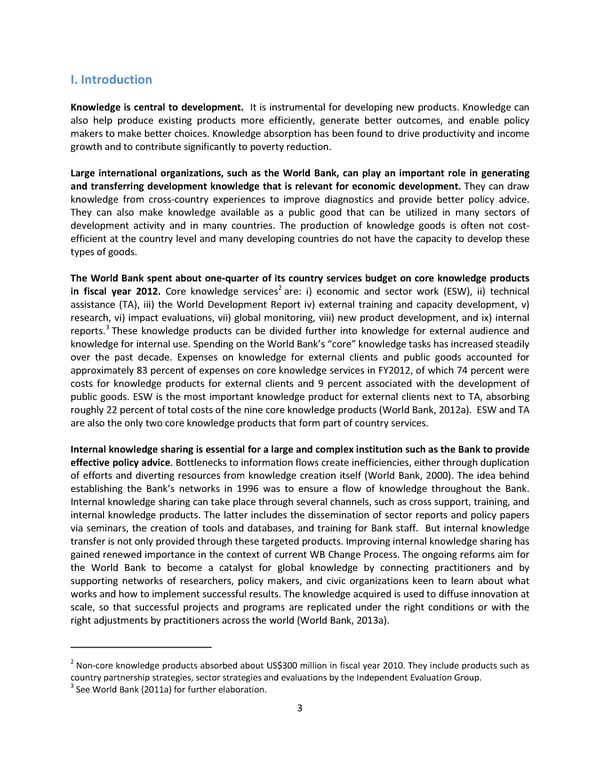I. Introduction Knowledge is central to development. It is instrumental for developing new products. Knowledge can also help produce existing products more efficiently, generate better outcomes, and enable policy makers to make better choices. Knowledge absorption has been found to drive productivity and income growth and to contribute significantly to poverty reduction. Large international organizations, such as the World Bank, can play an important role in generating and transferring development knowledge that is relevant for economic development. They can draw knowledge from cross-country experiences to improve diagnostics and provide better policy advice. They can also make knowledge available as a public good that can be utilized in many sectors of development activity and in many countries. The production of knowledge goods is often not cost- efficient at the country level and many developing countries do not have the capacity to develop these types of goods. The World Bank spent about one-quarter of its country services budget on core knowledge products in fiscal year 2012. Core knowledge services2 are: i) economic and sector work (ESW), ii) technical assistance (TA), iii) the World Development Report iv) external training and capacity development, v) research, vi) impact evaluations, vii) global monitoring, viii) new product development, and ix) internal reports.3 These knowledge products can be divided further into knowledge for external audience and knowledge for internal use. Spending on the World Bank’s “core” knowledge tasks has increased steadily over the past decade. Expenses on knowledge for external clients and public goods accounted for approximately 83 percent of expenses on core knowledge services in FY2012, of which 74 percent were costs for knowledge products for external clients and 9 percent associated with the development of public goods. ESW is the most important knowledge product for external clients next to TA, absorbing roughly 22 percent of total costs of the nine core knowledge products (World Bank, 2012a). ESW and TA are also the only two core knowledge products that form part of country services. Internal knowledge sharing is essential for a large and complex institution such as the Bank to provide effective policy advice. Bottlenecks to information flows create inefficiencies, either through duplication of efforts and diverting resources from knowledge creation itself (World Bank, 2000). The idea behind establishing the Bank’s networks in 1996 was to ensure a flow of knowledge throughout the Bank. Internal knowledge sharing can take place through several channels, such as cross support, training, and internal knowledge products. The latter includes the dissemination of sector reports and policy papers via seminars, the creation of tools and databases, and training for Bank staff. But internal knowledge transfer is not only provided through these targeted products. Improving internal knowledge sharing has gained renewed importance in the context of current WB Change Process. The ongoing reforms aim for the World Bank to become a catalyst for global knowledge by connecting practitioners and by supporting networks of researchers, policy makers, and civic organizations keen to learn about what works and how to implement successful results. The knowledge acquired is used to diffuse innovation at scale, so that successful projects and programs are replicated under the right conditions or with the right adjustments by practitioners across the world (World Bank, 2013a). 2 Non-core knowledge products absorbed about US$300 million in fiscal year 2010. They include products such as country partnership strategies, sector strategies and evaluations by the Independent Evaluation Group. 3 See World Bank (2011a) for further elaboration. 3
 Which World Bank Reports Are Widely Read? Page 8 Page 10
Which World Bank Reports Are Widely Read? Page 8 Page 10